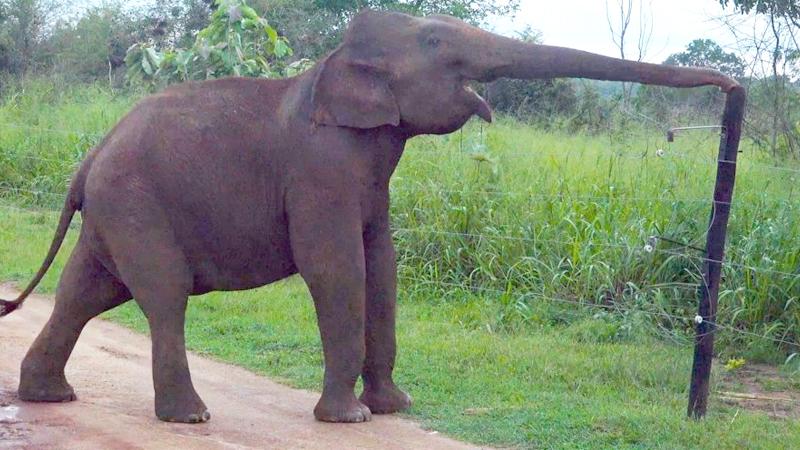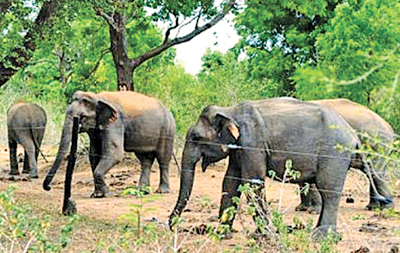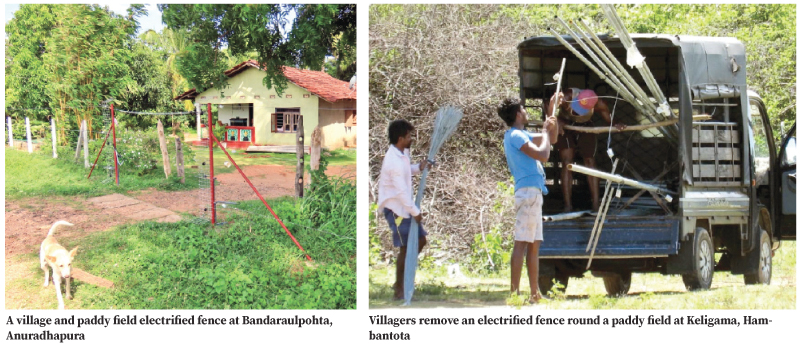
The growing trend of human-elephant conflict is a great menace. The findings of recent studies demonstrate that segregating people and elephants at a landscape by limiting elephants to protected areas has failed and is not seemingly a realisable objective. A study based on interviews of residents gleans information on the past presence of elephants in areas where elephants are now absent and where elephants were previously absent but now present.
People especially in the Dry Zone close to jungles frequently suffer untold hardships and inconvenience from the invasion and attacks by the elephants, destroying their cultivation, habitats and sometimes their lives.
 Every year around 100 people lose their lives due to wild elephant attacks with a similar number of people being seriously injured or wounded. Troubles and harm being caused by wild elephants to humans are almost endless whereas the harm caused by people to the elephants is also the same. In 2019, some 407 elephants and 122 people have died recording the highest annual death toll in recent history.
Every year around 100 people lose their lives due to wild elephant attacks with a similar number of people being seriously injured or wounded. Troubles and harm being caused by wild elephants to humans are almost endless whereas the harm caused by people to the elephants is also the same. In 2019, some 407 elephants and 122 people have died recording the highest annual death toll in recent history.
Factors such as large scale cultivation, clearing of large extents of forested land for human habitations and massive development projects cause wild elephants to lose their habitat.
Destructions
This has further infuriated the elephants thus leading them to cause even more destructions. The aggrieved poverty stricken village folks living in about 140 divisional Secretary Divisions in 19 districts in the country are the most affected due to the conflict.
President Gotabaya Rajapaksa in last year appointed a Presidential committee to formulate a national action plan for the mitigation of Human Elephant conflict. The Committee has recommended a complete change in the approach to the human – elephant conflict based on wider stakeholder participation and prioritising protection of settlements and cultivation from elephant depredation. They include constructing community based electric fences to prevent elephants entering or rather invading causing heavy damages to settlements and crop fields.
Electric fences with elephants present on both sides are to be relocated to the boundary of areas used by elephants. It is recommended that activities that may increase the conflict such as so-called elephant drives be minimised or discontinued after an appropriate evaluation of such acts, including a range of short, medium and long term conflict prevention methodologies.
The Presidential Committee has proposed that a Presidential Task Force be established to monitor implementation of the action plan proposals and recommendations. However, it is learnt that the wildlife conservation department has failed to realise the Presidential Committee’s Action plan even after one year passed since the report submitted to the President. However, the only viable option for elephants conservation and human-elephant conflict mitigation is a human elephant coexistence model with management of elephants in and outside protected areas.
Trenches
The wildlife conservation authorities have embarked on a program of using trenches as a barrier for elephants based on the premise that elephants don’t jump across obstructions as they weigh too much for the impact to be borne by their legs. The biggest problem with trenches is that they fill up with water during the rainy seasons, and sides cave in. Elephants will also put weight on the sides of trenches.
Lining trenches with concrete can stabilise the side and prevent the side caving in. However, such stabilisation tends to be expensive. However, after more than 60 years of various efforts, currently 70 percent of the elephant range is in areas with people. Sri Lanka has the highest level of human-elephant conflict in the world. It is obvious that confining elephants to protected areas has completely failed.
Under the circumstances, an alternative approach to human-elephant conflict mitigation has been developed and piloted by several organisations with the Centre for Conservation and Research (CCR) headed by environmental scientist Dr Prithiviraj Fernando leading over the past two decades. A fruitful step towards realisation of effective HEC mitigation has recently been taken with a number of donor funded projects and agencies taking up the challenge.
Two leading projects are the Climate Smart Irrigated Agriculture Project and the Eco-systems Services Conservation and Management Project funded by the World Bank. The North West Canal Project (NWCP) and the Upper Elahera Canal Project funded by the Asian Development Bank under the Mahaweli water security investment program were approved by the Central Environment Authority based on the agreement to implement a wildlife management plan addressing the wild life related issues being created by project implementation A major part of this will address the human – wildlife conflicts that will particularly the Human – Elephant conflict.
Coexistence model
 A herd of elephants close to a traditional electrified fence |
With regard to the plan of the Centre for Conservation and Research, the alternative approach is based on human – elephant coexistence model where conflict mitigation addresses the root cause which is crop raiding, by elephants and people trying to prevent such act using ineffective sometimes illegal confrontational methods.
The human elephant co – existence model is based on protecting human settlements, home gardens and crop cultivations mainly paddy through community - based electric fencing and creating awareness among farmers. These fence systems are categorised under two types such as permanent ones that protect settlements and seasonal fences protecting seasonal cultivations. Around 30 community based permanent electric fences and 35 seasonal fences have been constructed by CCR in Anuradhapura, Kurunegala, Hambantota, and Trincomalee districts. Recently a permanent community – based protective electric fence was constructed in Marakulama in Thirappanne and also in Keligama and Sathsurugama villages in Hambantota whereas another fence is under erection in Bandara Ulpotha in Kebitigollewa also in Anuradhapura.
On the other hand the most recent seasonal paddy field fences implemented by CCR are in Gal-wewa in Hambantota and Kumbulewewa and Weliwala Village in Galgamuwa, Kurunegala. The main stakeholders are the communities that are faced with the human elephant conflict, divisional secretaries, Agrarian Development, Agriculture and Irrigation Departments, Mahaweli authority and farmer organisations.
Community participation
The community participatory wild elephant electrified fence program being introduced by the Eco –System Conservation and Management project has become a successful methodology delivering promising results. One focus area of the program operated under the Ministry of Wildlife and Forest Conservation with the assistance of the World Bank is establishing human – elephant coexistence to protect the livelihoods of people. The basic task is to construct electrified fences with community participation according to project Director Anura Sathurusinghe. Work on protective electrified fence is implemented in two steps such as the electrified village fence and electrified paddy field fence.
The electrified fence for cultivation is constructed during the cultivation season and dismantled in the off season. As such the wild elephants on the surrounding forest cover get an opportunity of feeding themselves on the leftover cultivation in the fields and other sorts of flora sprouting on the locations remedying the dearth of food of wild elephants. But due to the electrified fence around the village or cluster of adjoining villages functioning day and night, elephants are unable to enter the villages.
The ESCAMP has chosen 47 habitations in the districts of Anuradhapura and Kurunegala where the Human-Elephant Conflict is fast growing. Electrified fences have been erected at Kaduruwewa, Wathupolagama, Thammiagama and Palamugedara Galedivulwewa, Koonwewa, Dewagiripura, kattakaduwa and Ihalagama in the Kurunegala district providing encouraging results.
The fence is being constructed with the labour of the affected villagers giving them the feeling that the fence is their asset and not a government property. The responsibility of the maintenance of the fence is entrusted to the wild elephant electrified fence society with all families in a particular village are members of it. The funds required for maintenance are provided by the society. In this issue, the Industrial Technology Institute works in collaboration with the ESCAMP project.
Shrinking habitat
According to Wildlife Conservation Department, elephants have lost around 16 percent of their range in the past 60 years. The Asian elephant population has been facing severe decline. However as disclosed by studies and research the Sri Lankan elephant population is still contiguous except for two small groups in the Wet Zone morefully in the Adams peak region and Sinharaja reserved forests.
The Government spends around Rs 600,000 or more to construct one kilometre of electrified fence. But the cost of materials for a fencing around a paddy cultivated area is Rs 250,000 per kilometre. On average a fence protecting a hamlet of 100 families as an example will be about 10km in length and costs around Rs 5.5 million.
There are no methods that prevent elephant depredation 100 percent. Many barrier methods have limited applicability.

